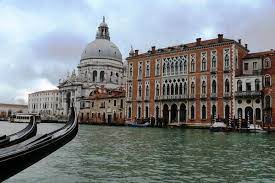Italy: Population drops below 50,000 for first time in Venice

Jon King
Venice: Stickers and banners bearing the number 49,999 have appeared on bridges and buildings in recent weeks in protest against a drop in residents in Venice’s old town. It is believed to be the first time the population has fallen below 50,000 in living memory.
Resident Matteo Secchi told German daily Frankfurter Allgemeine: “If it continues like this, we will become a ghost town like Pompeii.”

Twenty years ago Venice was home to 64,000 people but the population fell to 58,200 in 2012. It has now reached an historic low of 49,997, according to surveys by city authorities.
Mr Secchi and supporters from organisation Venessia.com are warning of a continuing exodus from the city, dubbed “Venexodus”, as young people grow tired of soaring food prices, increasing tourist numbers, high rents and going without cars.
Nine thousand people in Venice are under 18 while almost half who live there are 60 or older.
However, tourists continue to outnumber residents with more than 93,000 counted in Venice on Saturday, ahead of Ferragosto – the unofficial summer season peak.
Coronavirus restrictions had seen tourist numbers plummet, but travellers are returning to the city in droves.
Tourists from outside the Veneto area who do not want to stay in Venice overnight will be required to book their entry at a cost reportedly between three and 10 euros from next year.
The move is intended to curb the number of day-trippers visiting Venice’s centre, which includes St Mark’s Basilica and the Doge’s Palace.
However, a limit on tourist numbers has not been set, according to reports. City authorities announced the decision to bring in the entry fee after Venice was swamped by visitors over the Easter weekend.
Visitor numbers bounced back to pre-pandemic levels in the spring, prompting the Venetian authorities to act. It followed a ban on cruise ships entering the lagoon city’s waters.
The Italian Government acted after the United Nations’ culture organisation UNESCO threatened to put the country on a blacklist for not banning liners from the World Heritage site.
Mayor of Venice, Luigi Brugnaro, has denied the city is becoming a museum. The wider Venice area, including people who live on nearby islands, has a population of 77,000.
A total of 25,000 students and 35,000 commuters have also been recorded in Venice.
But it is a far cry from Venice’s historic status as the Mediterranean’s leading city.
The old town’s population decline has led Venessia.com supporters to compare Venice to Disneyland and an open-air museum.
When the number of residents fell below 60,000 in 2009, a procession of gondolas took part in a mock funeral in protest.
Pall bearers wearing black capes carried a flower-draped, pink coffin symbolising Venice’s “death” due to rampant tourism, rising sea levels, housing costs, a low birth rate and lack of services.





